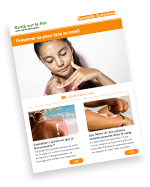L'hypersomnolence or excessive sleepiness is the tendency to doze off during the day when the situation does not lend itself to it and requires, on the contrary, the maintenance of wakefulness. This pathology affects nearly a quarter of the population and represents a public health issue given its consequences (e.g. domestic accidents, reduction in school or professional capacities, etc.).

What is hypersomnolence?
L'hypersomnolence is defined as an excessive amount of night and/or daytime sleep, and/or an impairment of wakefulness. The latter is described as the inability to maintain a satisfactory level of alertness.
To know more! There are many terms referring to this state of altered wakefulness: somnolence, excessive sleepiness, excessive daytime sleepiness, hypersomnolence, hypersomnia, hypovigilance, fatigue, etc.
It is estimated that 27.8 % of the general population is affected byhypersomnolence :
- 13.2 % of the population would describe recurrent episodes of the urge to sleep in a single day;
- 1.9 % of repeated naps in one day ;
- 0.7 % unrefreshing sleep despite sleeping for more than 9 hours;
- 4.4 % a sleeping intoxication.
Lhypersomnolence is most often related to: depression, sleep deprivation, obesity, certain medications and certain medical conditions, including sleep disorders such as sleep apnoea. However, the most severe forms of excessive sleepiness are usually caused by central hypersomnias (e.g. narcolepsy).
To know more! Central hypersomnias are rare diseases. Among them is narcolepsy (type 1 or 2) which causes the most severe form of hypersomnolence.
Management of central hypersomnias causing severe hypersomnolence
The term central hypersomnia covers several conditions: idiopathic hypersomnia (of unknown origin), Kleine-Levin syndrome and narcolepsy.
Type 1 narcolepsy (or narcolepsy with cataplexy) is a rare condition (20 to 30 cases per 100,000) characterised by two symptoms: a drowsiness This can lead to excessive daytime sleepiness and cataplexy (sudden loss of muscle tone). To date, there is no curative treatment; the molecules available (modafinil, methylphenidate, sodium oxybate, pitolisant and dextroamphetamine) have a stimulating action in order to limit drowsiness during the day. For the other symptom (catalepsy), sodium oxybate is also indicated.
However, unlike other central hypersomnias, the origin of which remains obscure, type 1 narcolepsy has been studied many times, which has made it possible to identify a biomarker (substance whose presence or absence signals an abnormal event).
This famous biomarker is a hypocretin. Hypocretins are peptides (protein building blocks) that are produced only by certain neurons and bind to their own cell receptors. Together they form the hypocretinergic system, which is known to be involved in various functions, including sleep.
In the vast majority of type 1 narcoleptic patients, hypocretin levels are reduced or absent with a decrease of almost 90% in the expression of the genes controlling these levels. The origin of this neuronal degeneration is not known, but the multifactorial approach is favoured, with a very probable autoimmune hypothesis.
A better knowledge of the pathology, in particular thanks to the discovery of a hypocretin deficiency in type 1 narcolepsy, makes it possible to envisage a curative treatment for this pathology and why not extend it to all central hypersomnias. Numerous avenues are being tested on animal models, for example the administration of hypocretin or hypocretinergic agonists (molecules mimicking the action of hypocretin). For the moment, the results are not conclusive enough to move on to human trials, but the coming years will certainly see the emergence of new innovative therapies. The many patients will therefore have to be patient for some time yet...
Charline D., Pharmacist


